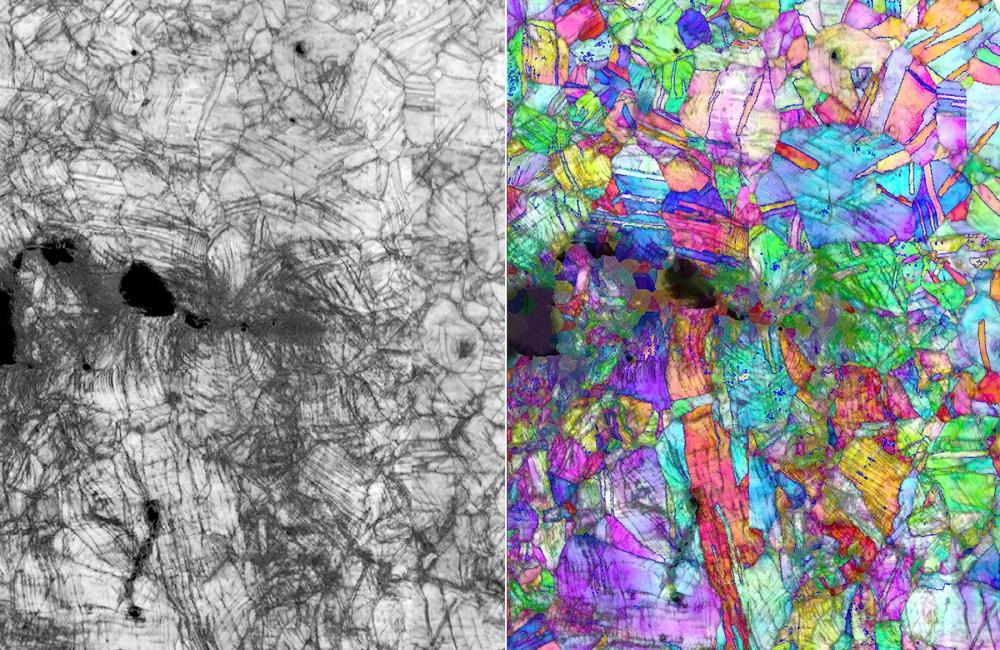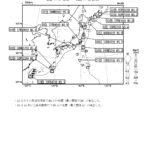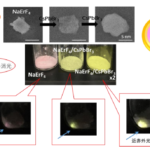2022-12-09 オークリッジ国立研究所(ORNL)

Microscopy-generated images showing the path of a fracture and accompanying crystal structure deformation in the CrCoNi alloy at nanometer scale during stress testing at 20 kelvin (-424 F). The fracture is propagating from left to right. Credit: Robert Ritchie/Berkeley Lab
CrCoNiは、高エントロピー合金、またはHEAと呼ばれる一群の金属のサブセットです。現在使われているすべての合金は、ある元素の割合が高く、追加される元素の量は少ないが、HEAは各構成元素が均等に混合されてできている。このバランスの取れた原子配列が、強度と延性を両立させ、いわゆる “タフネス “を生み出しているのだろう。HEAは約20年前に開発されて以来、注目されている研究分野である。しかし、極限状態での試験で材料を限界まで高めるのに必要な技術は最近までなかった。
バークレー研究所、ブリストル大学、ラザフォード・アップルトン研究所、ニューサウスウェールズ大学のリッチー、ジョージとその同僚たちは、中性子回折、電子後方散乱回折、透過電子顕微鏡を用いて、室温と20ケルビンで破壊されたCrCoNi試料の格子構造を調査した。
これらの技術から得られた画像と原子マップから、この合金の靭性は、力を加えたときに特定の順序で作用する3つの転位の障害によるものであることがわかった。まず、転位が移動することで、結晶の一部が平行な面上にある他の部分から滑り落ちます。この動きによって、ユニットセルの層がずれるため、滑りに対して垂直な方向のパターンが揃わなくなり、一種の障害となる。さらに金属に力が加わると、ナノツインニングと呼ばれる現象が起こり、格子の領域が鏡面対称になり、その間に境界線ができる。さらに、金属に力が加わり続けると、エネルギーによって単位格子の配列が変化し、CrCoNi原子は面心立方結晶から六方最密充填と呼ばれる別の配列に変化するのである。
研究チームの新しい発見は、HEAに関する他の最近の研究成果とともに、材料科学界に、物理的特性がどのように性能をもたらすかについての長年の通念を再考させるかもしれません。
CrMnFeCoNi合金は20ケルビンで試験され、印象的な性能を発揮しましたが、より単純なCrCoNi合金と同じ靭性を得ることは出来ませんでした。
<関連情報>
- https://www.ornl.gov/news/new-study-reveals-profound-properties-simple-metal-alloy
- https://www.science.org/doi/10.1126/science.abp8070
20ケルビンにおけるCrCoNi系中・高エントロピー合金の卓越した破壊靭性 Exceptional fracture toughness of CrCoNi-based medium- and high-entropy alloys at 20 kelvin
Dong Liu,Qin Yu,Saurabh Kabra,Ming Jiang,Paul Forna-Kreutzer,Ruopeng Zhang,Madelyn Payne,Flynn Walsh,Bernd Gludovatz ,Mark Asta,Andrew M. Minor ,Easo P. George,Robert O. Ritchie
Science Published:1 Dec 2022
DOI: 10.1126/science.abp8070
Too cold to fracture
Finding structural materials that have good fracture properties at very low temperatures is challenging but is important for fields such as space exploration. Liu et al. discovered a high-entropy chromium-cobalt-nickel alloy that has an incredibly high fracture toughness at 20 kelvin (see the Perspective by Zhang and Zhang). This behavior is caused by an unexpected phase transformation that, when combined with other microstructures, prevents crack formation and propagation. The fracture toughness of this alloy makes it potentially useful for a range of cryogenic applications. —BG
Abstract
CrCoNi-based medium- and high-entropy alloys display outstanding damage tolerance, especially at cryogenic temperatures. In this study, we examined the fracture toughness values of the equiatomic CrCoNi and CrMnFeCoNi alloys at 20 kelvin (K). We found exceptionally high crack-initiation fracture toughnesses of 262 and 459 megapascal-meters½ (MPa·m½) for CrMnFeCoNi and CrCoNi, respectively; CrCoNi displayed a crack-growth toughness exceeding 540 MPa·m½ after 2.25 millimeters of stable cracking. Crack-tip deformation structures at 20 K are quite distinct from those at higher temperatures. They involve nucleation and restricted growth of stacking faults, fine nanotwins, and transformed epsilon martensite, with coherent interfaces that can promote both arrest and transmission of dislocations to generate strength and ductility. We believe that these alloys develop fracture resistance through a progressive synergy of deformation mechanisms, dislocation glide, stacking-fault formation, nanotwinning, and phase transformation, which act in concert to prolong strain hardening that simultaneously elevates strength and ductility, leading to exceptional toughness.



